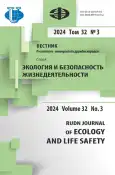Calculation of generalized indicators of radiation-ecological risk for areas of the Barents and Kara Seas exposed to the influence of nuclear and radiation hazardous objects
- Authors: Anikina N.A.1, Kryshev A.I.1
-
Affiliations:
- Research and Production Association “Typhoon”
- Issue: Vol 32, No 3 (2024)
- Pages: 274-285
- Section: Environmental Monitoring
- URL: https://journal-vniispk.ru/2313-2310/article/view/324074
- DOI: https://doi.org/10.22363/2313-2310-2024-32-3-274-285
- EDN: https://elibrary.ru/ZMRGSU
- ID: 324074
Cite item
Abstract
Most of the potential sources of radioactive contamination in the Arctic are located in the Barents and Kara Seas. In this regard, scientific research is regularly carried out in these territories, the results of which can be used to determine and analyze radiation and environmental risk. The goal and objective of the work is to calculate integral indicators of radionuclide pollution and generalized indicators of radiation-ecological risks in water and bottom sediments of the Barents and Kara Seas areas exposed to nuclear and radiation hazardous facilities. It is shown that the index ranges from 9.5·10-5 to 4.1·10-4 for water and from 1.2·10-4 to 1.3·10-2 for bottom sediments, which is much less than one. Calculated values of the risk indicator for K-159 range from 3 to 6, which corresponds to an insignificant radiation impact on the marine environment, for bays and the Novaya Zemlya depression from 12 to 18, which is characterized by a weak impact on the radiation situation. Thus, the objects under assessment have an insignificant and weak impact on the radiation situation in the Arctic region, but, taking into account the potential danger, they require constant monitoring of the components of the marine environment in order to timely detect radiation-ecological changes.
About the authors
Nelli A. Anikina
Research and Production Association “Typhoon”
Author for correspondence.
Email: rosnovskaya@rpatyphoon.ru
ORCID iD: 0000-0001-8839-5104
SPIN-code: 7199-4800
Engineer, Laboratory of Radiation-Ecological Modeling and Risk Analysis, Institute of Monitoring Problems
4 Pobeda St, Obninsk, 249031, Russian FederationAlexander I. Kryshev
Research and Production Association “Typhoon”
Email: kai@rpatyphoon.ru
ORCID iD: 0000-0001-6816-0260
SPIN-code: 5696-7633
Doctor of Biological Sciences, Leading Researcher, Laboratory of Radiation-Ecological Modeling and Risk Analysis, Institute of Monitoring Problems
4 Pobeda St, Obninsk, 249031, Russian FederationReferences
- Sivintsev YuV, Vakulovsky SM, Vasiliev AP. Technogenic radionuclides in the seas washing Russia. Radioecological consequences of radioactive waste disposal in the Arctic and Far Eastern seas. Moscow: Publishing House; 2005.
- Sazykina TG, Kryshev AI. Manifestation of radiation effects in cold environment: data review and modeling. Radiation and Environmental Biophysics. 2011;50(1):105-114.
- Aleksakhin RM. Nuclear energy and the biosphere. Moscow: Energoizdat; 1982.
- Polikarpov GG. Radiation ecology as a scientific basis for radiation protection of the biosphere and humanity. Ekaterinburg: Problems of radioecology and boundary disciplines. 2000;8:3-28.
- Kryshev II, Pavlova NN, Sazykina TG, Kryshev AI, Kosykh IV, Buryakova AA, Rosnovskaya NA. Assessment of environmental risk from radioactive pollution of the environment. Problems of risk analysis. 2023;20(3):10-26. http://doi.org/10.32686/1812-5220-2023-20-3-10-26
- Bulgakov VG, Katkova MN, Zapevalov MA, Gnilomedov VD, Semenova IV, Samsonov DP, Lukyanova NN, Surnin VA, Morshina TN. Concentrations of radioactive and toxic chemicals in bottom sediments of the Kara Sea. Meteorology and hydrology. 2023;(4):77-90. http://doi.org/10.52002/0130-2906-2023-4-77-90
- Jensen LK, Steenhuisen F, Standring W, Chen J, Leppanen AP, Nikitin AI, Kryshev AI, Gudnason K, Gwynn J, Stocki T, Joensen HP. Monitoring of radioactivity in the Arctic. AMAP Assessment 2015: Radioactivity in the Arctic. Oslo, AMAP; 2016.
- Gwynn JP, Nikitin AI, Shershakov VM, Heldal HE, Lind B, Teien HC, Lind OC, Sidhu RS, Bakke G, Kazennov A, Grishin D, Fedorova A, Blinova O, Sværen I, Liebig PL, Salbu B, Wendel C, Strålberg E, Valetova N, Petrenko G, Katrich I, Logoyda I, Osvath I, Levy I, Bartocci J, Pham MK, Sam AK, Nies H, Rudjord AL. Main results of the 2012 joint Norwegian - Russian expedition to the dumping sites of the nuclear submarine K-27 and solid radioactive waste in Stepovogo Fjord, Novaya Zemlya. Journal of Environmental Radioactivity. 2016;(151):417-426.
- Yoshitome R, Kunito T, Ikemoto T, Tanabe S, Zenke H, Yamauchi M, Miyazaki N. Grobal Distribution of Radionuclides (137Cs and 40K) in Marine Mammals. Environ. Sci. Technol. 2003;(37):4597-4602.
- Beresford NA, Wright SM, Brown JE, Sazykina TG. Transfer and Uptake Models for Reference Arctic Organisms. Review of approaches for the estimation of radioneclide transfer to reference Arctic biota; 2003.
- Gwynn JP, Brown JE, Kovacs KMb, Lydersen C. The derivation of radionuclide transfer parameters for and dose-rates to an adult ringed seal (Phoca hispida) in an Arctic environment. Journal of Environmental Radioactivity. 2006;(90):197-209.
- Gwynn JP, Nikitin AI, Shershakov VM, Heldal HE, Lind B, Teien HC, Lind OC, Sidhu RS, Bakke G, Kazennov A, Grishin D, Fedorova A, Blinova O, Sværen I, Liebig PL, Salbu B, Wendell CC, Strålberg E, Valetova N, Petrenko G, Katrich I, Logoyda I, Osvath I, Levy I, Bartocci J, Pham MK, Sam A, Nies H, Rudjord AL. Investigation into the radioecological status of Stepovogo fjord; 2012.
- Brown J, Børretzen P, Dowdall M, Sazykina T, Kryshev I. The derivation of transfer parameters in the assessment of radiological impacts on Arctic marine biota. Arctic. 2004;(57)3:279-289.
- Kryshev II, Sazykina TG, Strand P, Brown JE. Concentration factors of radionuclides in arctic marine biota. In: Proceedings from the 5th International Conference on Environmental Radioactivity in the Arctic and Antarctic. NRPA, Østerås; 2002.
- Rosnovskaya NA, Kryshev AI, Kryshev II. Determination of control levels of radionuclide content in water and bottom sediments of the Barents Sea, ensuring an acceptable environmental risk. Marine biological journal. 2022;((7)4):70-80. http://doi.org/10.21072/mbj.2022.07.4.06
- Rosnovskaya NA, Kryshev II, Kryshev AI, Katkova MN. Indicators of the quality of the marine environment according to the level of radionuclide activity for the Kara Sea ecosystem. Meteorology and hydrology. 2023;4:91-98. http://doi.org/10.52002/0130-2906-2023-4-91-98
Supplementary files









